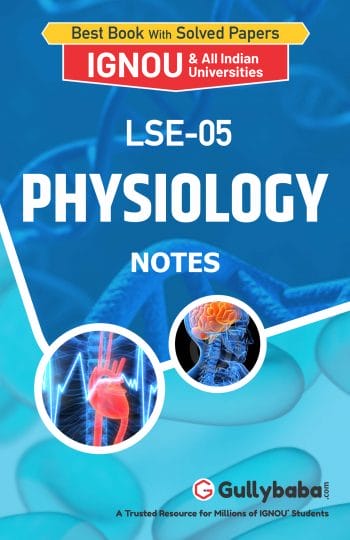Bought By: 8402
Rating: 4.3

Get Good Marks in your B.Sc. Life Science Programme in the Term-End Exams even if you are busy in your job or profession.
We've sold over 39,325,328 Help Books and Delivered 47,829,956 Assignments Since 2002.
As our customers will tell you...yes, it really result-oriented.
 3. a) Define the following:
i) Anatomical dead space
ii) Cardiac output
iii) Resting potential in a nerve cell
iv) Parthenogenesis
v) Pheromones
b) What do you understand by blood pressure? Explain the process of fluid transfer between the capillaries and tissue.
4. a) What does an oxygen dissociation curve show? Draw and compare the oxygen dissociation curves of haemoglobin and myoglobin.
b) Why do animals exhibit differences between their essential food requirements? Where does the absorption of carbohydrates, lipids and amino acids take place in the vertebrate body? Describe the method of glucose absorption.
5. a) Discuss the nature and functions of estrogen in mammals.
b) With the help of a diagram, discuss the formation and secretion of amino acid based hormones.
Part II-(Plant Physiology)
6. a) List the function of essential elements and describe any one of them.
b) Differentiate between macro nutrient and micro nutrient. Describe the role of any two micronutrients in plant metabolism.
7. Write notes on the following:
i) Biological clocks
ii) C4 plants
iii) Vernalization
iv) Senescence
8. a) Discuss Red Drop and Emerson Enhancement effect.
b) Draw and describe Z scheme to illustrate the movement of electron in PS I (Photosystem I) & PS II (Photosystem II).
c) Describe loading and unloading in sieve tubes.
9. a) What is the role of plant hormones in development and growth? Describe the effect of auxins and cytokinins plant parts.
b) Describe the ways how plant adapts to biological stresses.
10. a) List the main function of stomata. Describe the mechanism of stomatal opening with labeled diagram.
b) Describe the role of proton pump in active transport of protons across plasma-membrane.
3. a) Define the following:
i) Anatomical dead space
ii) Cardiac output
iii) Resting potential in a nerve cell
iv) Parthenogenesis
v) Pheromones
b) What do you understand by blood pressure? Explain the process of fluid transfer between the capillaries and tissue.
4. a) What does an oxygen dissociation curve show? Draw and compare the oxygen dissociation curves of haemoglobin and myoglobin.
b) Why do animals exhibit differences between their essential food requirements? Where does the absorption of carbohydrates, lipids and amino acids take place in the vertebrate body? Describe the method of glucose absorption.
5. a) Discuss the nature and functions of estrogen in mammals.
b) With the help of a diagram, discuss the formation and secretion of amino acid based hormones.
Part II-(Plant Physiology)
6. a) List the function of essential elements and describe any one of them.
b) Differentiate between macro nutrient and micro nutrient. Describe the role of any two micronutrients in plant metabolism.
7. Write notes on the following:
i) Biological clocks
ii) C4 plants
iii) Vernalization
iv) Senescence
8. a) Discuss Red Drop and Emerson Enhancement effect.
b) Draw and describe Z scheme to illustrate the movement of electron in PS I (Photosystem I) & PS II (Photosystem II).
c) Describe loading and unloading in sieve tubes.
9. a) What is the role of plant hormones in development and growth? Describe the effect of auxins and cytokinins plant parts.
b) Describe the ways how plant adapts to biological stresses.
10. a) List the main function of stomata. Describe the mechanism of stomatal opening with labeled diagram.
b) Describe the role of proton pump in active transport of protons across plasma-membrane.To attend IGNOU LSE-05 Term-End Examination, you must first submit your Assignments to the university and it is possible from the LSE-05 study material. You can solve all necessary Assignments using Help Books. This will help in gaining good marks.
All best wishes with our efforts that you do not meet any obstacle before attending examinations next year. You can pass the B.Sc. Life Science Programme Annual Exams with a good grade using Books/Materials from any one place at home or anywhere else!
ALL THE BEST!!!
Team GullyBaba